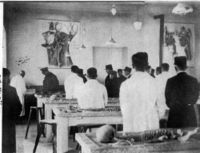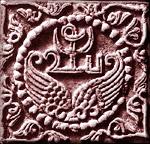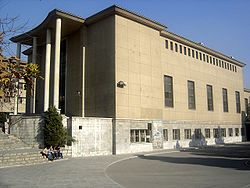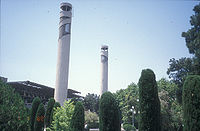历史
Main article: History of the University of Tehran
Most Faculties of the University of Tehran were created by integrating already existing higher education institutions such as Dar al-Funun.

Opening Ceremony of the Faculty of Medicine with Reza Shah.
In 1928 however, professor Mahmoud Hessaby proposed the establishment of a comprehensive institute which could cover most of the sciences to Ali Asghar Hekmat, the then Minister of Culture in the cabinet administration of Reza Shah.
Ali Asghar Hekmat, in collaboration and consultation with Andre Godard and a team of European architects, selected and designed the master plan of the university's main campus.
The University of Tehran officially inaugurated in 1934. The Amir-abad (North Karegar) campus was added in 1945 after American troops left the property as WWII was coming to an end. Other colleges and faculties were later either founded by or directly assisted and expanded by academic institutions of the United States.
The university admitted women as students for the first time in 1934, with a policy supporting universal education.
In 1986, by legislation of the National Parliament, the university's oversized College of Medicine separated into the independent Tehran University of Medical Sciences (TUMS), coming under the new Ministry of Health and Medical Education. The university (TUMS) is currently Iran's most prestigious medical school with 13,000 students. However, close collaboration between the university and Faculties of its sister University of Tehran continue in many areas of research.
Colleges
At present, UT comprises 40 faculties, institutes, and centers of research and education. The university consists of seven campuses:
- The central Pardis campus, on Enghelab Ave, is the oldest and the best known of the campuses.
- North Kargar Campus, where the dormitories are mostly located
- Karaj campus[1] of agriculture and natural resources
- Varamin College
- Kish College
- Qom College[2]
- Choka Campus
Former Campuses
- Karaj Campus, Formerly known as University of Tehran, School of Finance and Commerce until 1981 when it was rebranded as Allameh Tabatabaii University.
Emblems

The emblem of the University of Tehran was modeled after this Sassanid stucco relief discovered in Ctesiphon
The emblem of the University of Tehran, which was designed by Dr. Mohsen Moghadam, a late faculty member of the Faculty of Fine Arts, is based on an image, which can be found in the stucco relief and seals of the Sasanid period. In this case, it is a copy from a stucco relief discovered in the city of Ctesiphon.
The seal symbolized ownership. In the Sassanid period, these seals were used in stucco reliefs, coins, and silver utensils as a family symbol. Since the alphabet of Sasanid Pahlavi’s script was used in these badges, they have the nature of a monogram as well.
The motif is placed between two eagle wings. One can also find these motifs in other images of this period, such as in royal crowns, particularly at the end of the Sasanid period. Crowns with these seals have been called “two-feather crowns” in The Shahnameh. The motif between the wings was made by combining Pahlavi scripts. Some scholars have tried to read these images. The script is in the form of “Afzoot” (Amrood), which means plentiful and increasing.
Faculties

Entrance to the
College of Fine Arts. The main campus' architecture was largely inspired by early 20th century European designs.

The state of the art building for College of Engineering in Amir Abaad Campus
Initially University of Tehran included six faculties:
- Faculty of Theology
- Faculty of Science (1934)
- Faculty of Literature, Philosophy and Educational Science
- Faculty of Medicine (1934)
- Faculty of Pharmacy (1934)
- Faculty of Dentistry (1939)
- Faculty of Engineering (Fanni) (1942) (Persian: دانشکده فنی)
- Faculty of Law, Political and Economics
Later more faculties were founded:
- Faculty of Fine Arts (1941)
- Faculty of Veterinary Medicine (1943)
- Faculty of Agriculture (1945)
- Faculty of Management (1954)
- Faculty of Education (1954)
- Faculty of Natural Resources (1963)
- Faculty of Economics (1970)
- Faculty of Social Sciences (~1972)
- Faculty of Foreign Languages [3] (1989)
- Faculty of Environmental Studies (1992)
- Faculty of Physical Education
- Faculty of Geography (~2002)
- Faculty of World Studies (~2008)
In 1992, the faculties of Medicine, Dentistry and Pharmacology seceded to become the Tehran University of Medical Sciences but is still located at the main campus (The central Pardis).
Institutes
University of Tehran also co-ordinates several major institutes:
- Institute of Biochemistry and Biophysics
- Institute of Geophysics
- The International Research Center for Coexistence with Deserts
- Institute of History of Science [4]
- Institute for North American and European Studies [5]
- Institute of Electrotechnic
- Center for Women's Studies [6]
- Applied Management Research Center [7]
- Dehkhoda Dictionary Institute
- Vehicle, Fuel, and Environment Research Institute
- Turbo Machine Institute
- Institute of Petroleum Engineering
- Water Institute
- The Research Institute of Energy Planning and Management
- The Engineering Optimization Research Group
- Biomaterial Research Institute
- Advanced Material Research Institute
- Inorganic Material Research Institute
World Rankings
Academic Ranking of World Universities (ARWU/Shanghai Ranking)
2009 : International rank : 402-501 , National rank : 1
Times higher education ( In association with QS )
2009 : International rank : 368 , National rank : 1
2008 : International rank : 401-500 , National rank : 1
2007 : International rank : 539 , National rank : 2
Webometric ranking
2010 : International rank : 873 , National rank : 1
2009 : International rank : 987 , National rank : 1
2008 : International rank : 1083 , National rank : 1
2007 : International rank : 1463 , National rank : 1
Political role

UT's central mosque has been a center for religious and political activity in Tehran during the past 30 years.
University of Tehran's central place in Iranian elite circles has made it the setting for many political events and cultural works.
Perhaps, to historians, the University of Tehran is most notably remembered for its key roles in the political events of recent history. It was in front of the same gates of this school that The Shah's army opened fire on dissident students, killing many and further triggering the 1979 revolution of Iran. It was there and 20 years later in July 1999 that, albeit, a much smaller number of dissident students confronted the police.
University of Tehran (UT) has always been a bastion of political movement and ideology. At UT the leaders of the country deliver some of their most potent speeches often on Friday during prayers. Since the 1979 Islamic Revolution, the main campus of the university and its surrounding streets have been the site for Tehran's Friday prayers.
The political and social role of University of Tehran in the Iranian domestic arena has continued to be so pronounced that in November 2005 (to February 2008) a senior Islamic scholar became chancellor of the university, replacing Dr. Faraji-dana (professor of electrical engineering faculty). Ayatollah Abbasali Amid Zanjani (عباسعلی عميد زنجانی) is a professor in Law, is known for his strong ties to Ayatollah Khomeini in the 1979 revolution, and had spent time in the Shah's prisons before the Islamic Revolution. In February 2008, an Iranian economist, Dr. Farhad Rahbar, a former vice president of Iran and head of Management and Planning Organization of Iran, became the new (31st) chancellor of the university.
One hundred and nineteen faculty members of the University of Tehran is said to have resigned on June 15, 2009 to protest the attack on university dorms in the wake of contested 2009 presidential elections.
Notable people
See also: List of University of Tehran people
Picture Gallery
School of Engineering Main Building known as Faculty of Engineering Building
|
School of Engineering Main Building seen in the far
|
The new School of Engineering state of the art buildings in Amir Abad campus
|
|
|
|
|
School of literature and Humanities. The campus architecture has influences from the architecture of Persian antiquity (compare to Persepolis)
|
School of literature and Humanities in snow
|
School of Business and Economy Building
|
School of Business and Economy Building
|
School of Business and Economy Building
|
更多
 |
Wikimedia Commons has media related to: University of Tehran |
- Tehran University main entrance
- Shahid Beheshti University
- Higher education in Iran
- Academy of Gundishapur
- Nizamiyyah
- List of universities in Iran
- Dar al-Funun
- Tehran University of Medical Sciences, part of University of Tehran until 1986.
参考文献
- ^ University of Tehran, Dr. Mahmoud Hessaby
- ^ http://ut.ac.ir/en/main-links/overview.htm
- ^ Link: http://www.mehrnews.com/fa/NewsDetail.aspx?NewsID=445096
- ^ Iranica.Com - Faculties Of The University Of Tehran
- ^ Lorentz, J. Historical Dictionary of Iran. 1995. ISBN 0-8108-2994-0
- ^ Logo of the University of Tehran
- ^ http://www.hessaby.com/
- ^ http://www.arwu.org
- ^ http://www.topuniversities.com/university/1089/university-of-tehran
- ^ http://www.webometrics.info
- ^ http://andrewsullivan.theatlantic.com/the_daily_dish/2009/06/tehran-universitys-faculty-resigns-en-masse.html
External links
- University of Tehran 网址 (English)
- Tehran University of Science's Central Library
- promotional video on the University of Tehran - Youtube



